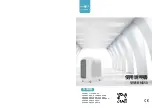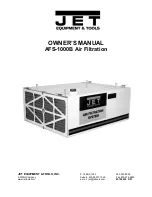
19
Installation Guide
| Comfort Pack with 80% Gas Heat
Clearances
Clearance to combustibles is defined as the minimum distance
from a heater to a surface or object that is necessary to ensure
that a surface temperature of 90°F above the surrounding
ambient temperature is not exceeded. Minimum clearance
to combustibles from all sides of this properly installed unit
is zero inches. Adequate clearances must be provided to
allow installation of the union and shutoff valve, as well as
accessibility to wiring and control compartments. If this unit
is installed in an attic or other insulated space, it must be kept
free and clear of insulating material. The area must be inspected
when the unit is installed or insulation is added. Some insulating
materials may be combustible. (See page 11 for other clearances)
Venting
The venting system is an integral part of the heater as shipped to
you. Do not modify or add to the vent system. The heat section
includes an exhaust blower. The blower draws the combustion
products out of the heat exchanger, mixes combustion products
with dilution air and forces the mixture to the outside. A chimney
is not required. No special provisions are required for supplying
air for combustion. Do not alter or extend the vent outlet. The
venting system is designed for proper operation under all
weather conditions and for winds up to 40 mph. (See page 11
for locating vent)
Gas Piping and Pressures
THIS HEATER IS EQUIPPED FOR A MAXIMUM
GAS SUPPLY PRESSURE OF 1/2 POUND, 8
OUNCES OR 14 INCHES WATER COLUMN.
SUPPLY PRESSURE HIGHER THAN 1/2
POUND REQUIRES INSTALLATION OF
AN ADDITIONAL LOCKUP-TYPE SERVICE
REGULATOR EXTERNAL TO THE UNIT.
!
WARNING
Gas piping external to the unit must include: a manual
shutoff valve with 1/8" NPT plugged tapping (for test
gauge connection), drip leg and ground union fitting.
If the supply air from the unit is ducted to space(s)
outside the space containing the unit, the return air
must be ducted from outside the space containing the
unit and sealed to the unit cabinet return air opening.
Pressure Testing Supply Piping
Test Pressures Above 1/2 PSI:
Disconnect the heat manual valve
from the gas supply line that is to be tested. Cap or plug the
supply line.
Test Pressures Below 1/2 PSI:
Before testing, close the manual
valve on the heater.
All piping must be in accordance with requirements outlined
in the National Fuel Gas Code ANSI/Z223,1a (latest edition) or
CAN/ CGA-B149.1 and B149.2. Gas supply piping installation
should conform with good practice and the local codes. Support
gas piping with pipe hangers, metal strapping or other suitable
material; do not rely on the heater to support the gas pipe.
CAPACITY OF PIPING
Cubic Feet Per hour Based on 0.3” w.c. Pressure Drop
Specific Gravity for Natural Gas - 0.6 (Natural Gas - 1000 BTU/Cubic Feet)
Specific Gravity for Propane Gas - 1.6 (Propane Gas - 2550 BTU/Cubic Feet
)
LENGTH
OF
PIPE
DIAMETER OF PIPE
1/2”
3/4”
1”
1 1/4”
1 1/2”
2”
NATURAL
PROPANE NATURAL PROPANE NATURAL PROPANE NATURAL PROPANE NATURAL PROPANE NATURAL PROPANE
20’
92
107
190
116
350
214
730
445
1100
671
2100 1281
30’
73
45
152
93
285
174
590
360
890
543
1650 1007
40’
63
38
130
79
245
149
500
305
760
464
1450
885
50’
56
34
115
70
215
131
440
268
670
409
1270
775
60’
50
31
105
64
195
119
400
244
610
372
1105
674
70’
46
28
96
59
180
110
370
226
560
342
1050
641
80’
43
26
90
55
170
104
350
214
530
323
990
604
90’
40
24
84
51
160
98
320
195
490
299
930
567
100’
38
23
79
48
150
92
305
186
460
281
870
531
125’
34
21
72
44
130
79
275
168
410
250
780
476
150’
31
19
64
39
120
73
250
153
380
232
710
433
160’
28
17
59
36
110
67
225
137
350
214
650
397
170’
26
16
55
34
100
61
210
128
320
195
610
372
Note:
When sizing lines, consider possibilities of future expansion
and increased requirements. Refer to National Fuel Gas Code for
additional information on line sizing.
T
he heater is orificed for operation with natural gas having a
heating value of 1000 (+/-50) BTUH per cubic feet or propane
gas with a heating valve of 2500 (+/-100) BTUH per cubic feet.
If the gas at the installation does not meet these specifications,
consult the factory for proper orificing.
Pipe joint compounds
(pipe dope) shall be resistant to the action of liquefied
petroleum gas or any other chemical constituents of the gas
being supplied.
Install a ground joint union and manual shut off valve upstream of
the unit control system, as shown in Figure 2. The 1/8” plugged
tapping in the shut off valve provides connection for a supply
line pressure test gauge**. The National Fuel Gas Code requires
the installation of a trap with a minimum 3" drip leg. Local codes
may require a minimum drip leg longer than 3" (typically 6"). Gas
connection is 1/2". Leak-test all connections by brushing on a
leak-detecting solution.
Содержание Comfort Pack U Series
Страница 2: ......
















































